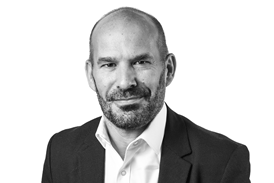Nobody knows better than Sir Martin Laing, former chairman of Laing, how a wafer-thin margin can turn into a catastrophic loss. He tells us about how a contract used to be a gentlemen’s agreement and why he wasn’t to blame for that £1 sale.

Sir Martin Laing is a man who knows about the ups and downs of contracting. During a career that spanned 36 years, he rose to become executive chairman of the 150-year-old construction firm that bore his family name. Then, in an example of how fickle the contractor’s lot can be, he oversaw the disastrous period that led to Laing’s construction arm – which at the time was just about the most famous name in the whole industry – being sold off for a single pound.
Unsurprisingly, when he meets ∫⁄∂¥…Á«¯ in the bar of a central London hotel, Sir Martin isn‚Äôt keen to discuss much of this. He is understandably wary of the press ‚Äì particularly since the Investors Chronicle branded him one of the worst bosses in the City three-and-a-half years ago ‚Äì and he gives few interviews. What he is prepared to talk about is his career in construction and how the industry changed over those 36 years.
The early years
Sir Martin started his career on site at his family’s housing division in Leeds. He stayed there for four years. The pressure to join his family’s empire must have been immense, and this is borne out by his shrug of the shoulders when asked if he had ever considered rebelling and following a different career path: “I was the eldest son. It was expected I would have to be involved.”
The period that Sir Martin seems to have really enjoyed was the 1970s. When he discusses his adventures with Laing in those years, his habitual hangdog expression gives way to a nostalgic smile. He ventured overseas – a marketing role in Saudi Arabia, a spell in Canada and four years in Egypt – before returning in 1981 to take up his inheritance as a Laing board member.
“Travel was the great thing about working for a big company,” he explains. “I’m surprised by the ways people don’t take advantage of their opportunities.”
Chairman Laing
Sir Martin, on the other hand, took the opportunity to bring back ideas he had developed abroad. Returning from Canada, he decided it was time to pioneer turnkey construction, providing every part of the building from main contracting to the lock on the front door. “It was too early. The market wasn’t ready for it.” Today its use is widespread, and he notes that this is one way the industry has evolved.
By 1983, he was chairman. Vaughan Burnand, who is now the managing director of Shepherd Construction, was a regional estimator at Laing during the 1980s. In a training course he attended, Burnand says Sir Martin told the class: “There isn’t a day I don’t think of a new business opportunity.”
The biggest opportunity was but a few years away. The concessions market, the construction and asset management model that was to lead to the development of the PFI, was growing in the early 1990s, particularly with toll roads in Spain. Sir Martin makes the rather eyebrow-raising claim that it was at this point the board came up with the idea of becoming a concessions business. This is the blueprint of what the company is today:
We had wanted to sell the construction business for five, six, seven years. The risk-reward ratios were all wrong … It was obviously emotional in terms of the staff, but no business decision can ever be particularly emotional
a PFI investment business that has put the dark ages of construction behind it to become a £480m-turnover, £25m pre-tax profit success story.
So when the PFI arrived big time with major contracts in the latter years of the Major government and the start of the Tony Blair era, Laing was keen to get involved as soon as possible. Sir Martin acknowledges that construction was changing dramatically around this time, with the whole process becoming more sophisticated and speed and guaranteed quality of work growing in importance to the client. The PFI was the epitome of this and perhaps it was something he was not really prepared for.
This is suggested by the way Sir Martin harks back to his grandfather’s era: “He would shake hands at the beginning of a job, and he had a commitment to do the job properly based on trust. It was a gentlemen’s agreement; a single sheet of paper.” If that’s what he wanted, he wasn’t going into the right area: a PFI contract easily fills a whole boardroom. There was a general feeling that Sir Martin was of a very different age.
The end of an era
In 1997 the National Physical Laboratory in Teddington, west London, was seen as the PFI that could make Laing the major player in the market. But, along with problems on the Millennium Stadium project in Cardiff, the laboratory, which is still incomplete eight years later, was one of the two contracts that brought the construction division to its knees. It is worth observing that the NPL was notable by its absence from the £1 sale of Laing Construction.
Sir Martin dismisses the persistent rumour that the construction division told the board that the contract could be a dangerous one to undertake. Either way, it was to become so – with the problem of temperature control simply getting out of control. One extra person going into a room could raise the thermostat by one degree. This seemingly simple problem was the major factor in the £70m hit Laing took on the scheme in 2001. Earlier this year, the government finally paid Laing’s consortium, Laser, a £75m termination payment and went back to the market to complete the remaining 40% of the site.
Amazingly, Sir Martin uses the disaster to praise the merits of the PFI: “NPL proved PFI [was effective] in terms of the client, as it handed the risk of the job over to the client. The risk passed from the government client to the owner-operator. For the contractor the risks were greater, but the rewards were also greater.”
Developing his theory of the risk-reward ratio, Sir Martin makes an unexpected declaration, that “we had wanted to sell the construction business for five, six, seven years. The risk-reward ratios were all wrong.” It is certainly true that the construction industry was only making a margin of 1-3% on its contracts, leaving it susceptible to making a loss if there were even the slightest cost overruns, let alone the epic failure on the NPL. But the received wisdom is that Laing was forced to sell the construction business to save its hide from a market that halved the parent group’s share price upon the announcement in 2001 of the subsidiary’s performance.
Remember, too, this was the business his family’s vast fortune – some £145m according to The Sunday Times Rich List – and reputation were built on. For a man who looks so nostalgically back to his grandfather’s time and whose strong sense of duty led him to join Laing himself, Sir Martin offers a rather hard-nosed view of the sale: “It was obviously emotional in terms of the staff, but no business decision can ever be particularly emotional.”
Life after Laing
The fact I picked up so many jobs afterwards seems to mean people didn’t think I was to blame. As far as I was concerned, I wasn’t to blame
“The City is not my favourite place,” Sir Martin says, his expression falling. “The City is a pretty cruel place. The banks are happy to lend you money; at the first sign of anything going wrong …” He tails off.
When Sir Martin stood down as executive chairman following the sale, he remained a non-executive director. Many analysts were fuming, demanding he quit altogether. One asked at the time: “What’s he going to do? Wander around the corridors like a ghost?”
He has since resigned from Laing’s board and the family shareholding is now a relatively insignificant single-digit stake.
Sir Martin says he understands that the City needs a victim in the kind of situation he found himself in, but refuses to take the blame for the demise of the construction arm. He says: “The fact I went and picked up so many jobs afterwards seems to mean that people didn’t think I was to blame. As far as I was concerned, I wasn’t to blame.” He adds: “Big businesses have to delegate responsibility.”
It’s true that Sir Martin has had a number of jobs in the past few years, including chairing a government sustainability taskforce, being on the financial advisory board of Pricewaterhouse Coopers and becoming the first foreigner on the board of US infrastructure group Parsons Brinckerhoff. It is also true that no chairman can completely control what happens at site level.
It is also fair to say that Ray O’Rourke, the recipient of the £1 construction arm, has been transforming the combined group, Laing O’Rourke into an empire, with the ultimate goal of becoming a £5bn business seemingly within its grasp.
O’Rourke is developing a business model whereby he can provide the complete construction service. Not only will he build the thing, he is looking to do all the subcontracting, from piling to electrical engineering. This is quite at odds with the more outsourcing project management style that the likes of Bovis Lend Lease are following, where about 80% of a project might be farmed off to subbies.
Sir Martin doesn’t like the Laing O’Rourke model. “All the models have a place,” he says, “but a lot of contractors that work for their own property company, for instance, fall out, saying that they haven’t got the best deal [as they are part of the same company, rather than in a competitive environment]. Fully integrated companies are fine on paper, but all those bits that have to work together start falling out.”
The final word
Sir Martin is often keen to dismiss the construction industry. At one point he exclaims: “It’s boring, isn’t it?” – meaning in comparison to the IT and media businesses. He particularly laments how low margins mean that contractors are unable to invest in the research and development that would make the sector all that more dynamic.
But a genuine passion for the sector occasionally rises to the surface, no more so than when he announces: “Construction’s a fascinating business. You get to see things you’ve created. There’s the fact you can travel and there are so many opportunities, from marketing to programming.” Which, coming from a man who spent 36 years in the business and experienced myriad frustrations and tribulations, is a pretty good recommendation.
Topics
Who'd be a contractor?
- 1
- 2
- 3
 Currently reading
Currently readingNo regrets
- 4
- 5






























No comments yet